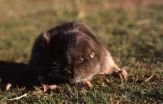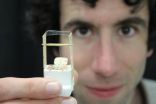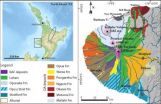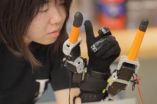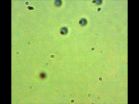(Press-News.org) Lincoln, Neb., July 18, 2014 -- A research team led by Scott Gardner of the University of Nebraska-Lincoln has identified four new species of Ctenomys, a genus of gopher-like mammal found throughout much of South America.
Commonly called tuco-tucos, the burrowing rodents range from 7 to 12 inches long and weigh less than a pound. They demonstrate the broad range of biological diversity in the lowlands and central valleys of Bolivia, where all four new species were found, Gardner said.
It is very rare to identify a new species of mammal, said Gardner, director of the H.W. Manter Laboratory of Parasitology and a curator for the University of Nebraska State Museum.
"In the current environment of human-caused environmental disturbance and degradation, the discovery of four previously unknown species that are relatively large in size is phenomenal," he said.
Three of the newly identified animals -- Ctenomys erikacuellarae or Erika's tuco-tuco; Ctenomys andersoni, or Anderson's cujuchi; and Ctenomys lessai, or Lessa's tuco-tuco -- were found in an area of high ridges that create deep river valleys in central Bolivia. Though the animals share common evolutionary forebears, the ridges, created by the same fierce geological pressures that thrust up the Andes, establish a geographical isolation that fostered the development of distinct species in different valleys.
The fourth new species, Ctenomys yatesi, or Yates' tuco-tuco, was found in the lowlands of eastern Bolivia. Though scientists earlier included it as part of previously identified Ctenomy species, Gardner's research team concluded it was distinctly different from any other species.
"The area from which these mammals were collected is still relatively unknown in a biological sense, even though this is the eastern foothills of the Andes, with among the highest level of biodiversity anywhere," Gardner said, adding that he expects more new species of mammals will eventually be found in the area.
As many as 65 tuco-tuco species are known to exist throughout South America. With the four new species, there have been a dozen found in Bolivia alone.
The new tuco-tuco species were described in a research paper published earlier this month in a special publication of the Museum of Texas Tech University (No. 62, June 17).
Gardner collaborated on the project with curators at the Museum of Southwestern Biology at the University of New Mexico in Albuquerque and with the American Museum of Natural History in New York. His co-authors were Jorge Salazar-Bravo of Texas Tech's Department of Biological Sciences and Joseph A. Cook of the University of New Mexico.
Identification of the new species was the result of National Science Foundation-funded work Gardner began as a graduate student in the 1980s. He was interested in learning more about the parasites that infested tuco-tucos, but first needed to distinguish the rodent species.
"As we went along, it turned out these species were more unique than we realized and we collected more and more as we moved through different places," Gardner recalled. "It turned out we could actually tell they were different by looking at their chromosomes and their DNA sequences."
Gardner assembled the data and examined a couple hundred specimens collected over three decades.
Each species was named for colleagues, some of whom participated on the project. Ctenomys erikacuellarae was named in honor of Erika Cuellar, a Rolex award-winning conservation biologist from Bolivia who participated in field expeditions as a student in the 1990s. Ctenomys yatesi was named in honor of the late Terry L. Yates, curator of the Mammal Division of the Museum of Southwestern Biology and later a vice president of the University of New Mexico. Ctenomys andersoni was named in honor of Sydney Anderson, expedition leader and curator emeritus of the Department of Mammalogy at the American Museum of Natural History. Ctenomys lessai was named in honor of Enrique P. Lessa, an expert in Latin American mammalogy, evolution and the biology of tuco-tucos.
Though some biologists recently have criticized the collection of specimens as potentially jeopardizing fragile populations of rare animals, Gardner said collecting expeditions to biologically unknown areas remain a critical part of understanding life on the planet.
"The No. 1 cause of extinction of organisms is loss of habitat," he said. "Because of large-scale human-caused habitat destruction occurring worldwide, it is essential to create collections of organisms now and use modern methods of systematics and ecology to understand the history of life on earth, while we still can. Time is limited."
INFORMATION:
CONTACT: Scott Gardner, Professor, Biological Sciences; Curator, University of Nebraska State Museum, 402-472-3334, slg@unl.edu
PHOTOS: Two photos connected with this news release are available for download at the University Communications website. Details are at the end of the release.
Four new species of tuco-tucos identified from Bolivia
'Ctenomys,' or tuco-tucos, are gopher-like mammals found throughout much of South America
2014-07-18
ELSE PRESS RELEASES FROM THIS DATE:
New material puts a twist in light
2014-07-18
Scientists at The Australian National University (ANU) have uncovered the secret to twisting light at will. It is the latest step in the development of photonics, the faster, more compact and less carbon-hungry successor to electronics.
A random find in the washing basket led the team to create the latest in a new breed of materials known as metamaterials. These artificial materials show extraordinary properties quite unlike natural materials.
"Our material can put a twist into light – that is, rotate its polarisation – orders of magnitude more strongly than natural materials," ...
In alcohol abusers, fish oil may reduce risk of neurodegeneration and ensuing dementia
2014-07-18
MAYWOOD, Ill-- Omega-3 fish oil might help protect against alcohol-related neurodamage and the risk of eventual dementia, according to a study published in the journal PLOS ONE.
Many human studies have shown that long-term alcohol abuse causes brain damage and increases the risk of dementia. The new study found that in brain cells exposed to high levels of alcohol, a fish oil compound protected against inflammation and neuronal cell death.
The study was conducted by Michael A. Collins, PhD, Edward J. Neafsey, PhD, and colleagues at Loyola University Chicago Stritch ...
Weight management program also reduces depression among black women
2014-07-18
DURHAM, N.C. -- An intervention program aimed at helping obese women maintain their weight without adding pounds also significantly reduced depression in nearly half the participants, according to a new study from Duke University.
The study was conducted with 185 low-income black women ages 25-44, each with a body mass index (BMI) of 25 to 35, who were receiving primary care at five community health centers in central North Carolina.
The program used software built by Duke researchers that personalized a weight-gain prevention intervention called the Shape Program for ...
Catastrophic debris avalanches -- a second volcanic hazard
2014-07-18
Boulder, Colo., USA – Volcanic hazards aren't limited to eruptions. Debris avalanche landslides can also cause a great deal of damage and loss of life. Stratovolcanoes, with their steep, conical shapes made up of lava and unconsolidated mixed materials, can reach a critical point of instability when they overgrow their flanks. This leads to partial collapse, and the product of this slope failure is a large-scale, rapid mass movement known as a catastrophic landslide or debris avalanche.
In a matter of minutes, a debris avalanche can drastically modify the shape and nature ...
Bowel cancer breakthrough may benefit thousands of patients
2014-07-18
Researchers at Queen's University have made a significant breakthrough that may benefit patients with bowel cancer.
Dr Sandra van Schaeybroeck and her team have discovered how two genes cause bowel cancer cells to become resistant to treatments used against the disease. The research, which was funded by Cancer Research UK, was published this month in the prestigious international journal Cell Reports.
The activity of the two genes, called MEK and MET, was uncovered when the researchers looked at all the different pathways and interactions taking place in bowel cancer ...
Scientists enlist big data to guide conservation efforts
2014-07-18
Despite a deluge of new information about the diversity and distribution of plants and animals around the globe, "big data" has yet to make a mark on conservation efforts to preserve the planet's biodiversity. But that may soon change.
A new model developed by University of California, Berkeley, biologist Brent Mishler and his colleagues in Australia leverages this growing mass of data – much of it from newly digitized museum collections – to help pinpoint the best areas to set aside as preserves and to help biologists understand the evolutionary history of life on Earth. ...
A new measure of biodiversity
2014-07-18
A new approach to measuring biodiversity has uncovered some biologically important but currently unprotected areas in Western Australia, while confirming the significance of the world heritage listed Wet Tropics rainforests in the country's north-east.
In a paper published yesterday (Friday 18 July) in Nature Communications, scientists from CSIRO, University of California, University of Canberra, the Australian Tropical Herbarium at James Cook University and University of New South Wales applied the new method to Australia's iconic Acacia.
The genus Acacia includes ...
Getting a grip on robotic grasp
2014-07-18
CAMBRIDGE, MA -- Twisting a screwdriver, removing a bottle cap, and peeling a banana are just a few simple tasks that are tricky to pull off single-handedly. Now a new wrist-mounted robot can provide a helping hand — or rather, fingers.
Researchers at MIT have developed a robot that enhances the grasping motion of the human hand. The device, worn around one's wrist, works essentially like two extra fingers adjacent to the pinky and thumb. A novel control algorithm enables it to move in sync with the wearer's fingers to grasp objects of various shapes and sizes. Wearing ...
Biomarker discovery may lead to new HIV treatment
2014-07-18
Further analysis of a Phase II study of therapeutic HIV vaccine candidate Vacc-4x revealed a potential biomarker associated with participants who experienced a more profound viral load reduction after receiving the vaccine. The results of this exploratory, ad hoc, subset analysis by St George's, University of London and Bionor Pharma were announced today at the AIDS 2014 Conference in Melbourne, Australia.
If confirmed, the biomarker may be able to predict which patients will benefit most from the therapeutic HIV vaccine candidate Vacc-4x, which is being developed by ...
'Nanocamera' takes pictures at distances smaller than light's own wavelength
2014-07-17
VIDEO:
This is a video demonstrating scanning-stage-based exposure, whereby programmed
motion of a microscope stage is used to write the University's "Block I " logo into the plasmonic film. Each bar in the...
Click here for more information.
Researchers at the University of Illinois at Urbana-Champaign have demonstrated that an array of novel gold, pillar-bowtie nanoantennas (pBNAs) can be used like traditional photographic film to record light for distances that ...
LAST 30 PRESS RELEASES:
Numbers in our sights affect how we perceive space
SIMJ announces global collaborative book project in commemoration of its 75th anniversary
Air pollution exposure and birth weight
Obstructive sleep apnea risk and mental health conditions among older adults
How talking slows eye movements behind the wheel
The Ceramic Society of Japan’s Oxoate Ceramics Research Association launches new international book project
Heart-brain connection: international study reveals the role of the vagus nerve in keeping the heart young
Researchers identify Rb1 as a predictive biomarker for a new therapeutic strategy in some breast cancers
Survey reveals ethical gaps slowing AI adoption in pediatric surgery
Stimulant ADHD medications work differently than thought
AI overestimates how smart people are, according to HSE economists
HSE researchers create genome-wide map of quadruplexes
Scientists boost cell "powerhouses" to burn more calories
Automatic label checking: The missing step in making reliable medical AI
Low daily alcohol intake linked to 50% heightened mouth cancer risk in India
American Meteorological Society announces Rick Spinrad as 2026 President-Elect
Biomass-based carbon capture spotlighted in newly released global climate webinar recording
Illuminating invisible nano pollutants: advanced bioimaging tracks the full journey of emerging nanoscale contaminants in living systems
How does age affect recovery from spinal cord injury?
Novel AI tool offers prognosis for patients with head and neck cancer
Fathers’ microplastic exposure tied to their children’s metabolic problems
Research validates laboratory model for studying high-grade serous ovarian cancer
SIR 2026 delivers transformative breakthroughs in minimally invasive medicine to improve patient care
Stem Cell Reports most downloaded papers of 2025 highlight the breadth and impact of stem cell research
Oxford-led study estimates NHS spends around 3% of its primary and secondary care budget on the health impacts of heat and cold in England
A researcher’s long quest leads to a smart composite breakthrough
Urban wild bees act as “microbial sensors” of city health.
New study finds where you live affects recovery after a hip fracture
Forecasting the impact of fully automated vehicle adoption on US road traffic injuries
Alcohol-related hospitalizations from 2016 to 2022
[Press-News.org] Four new species of tuco-tucos identified from Bolivia'Ctenomys,' or tuco-tucos, are gopher-like mammals found throughout much of South America
